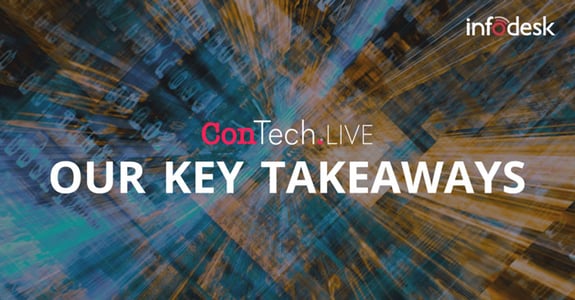Having returned from ConTech 2019, we’ve taken some time to reflect on some of the insights we gained from the array of speakers, exhibitors, and the conversations we had with the attendees.
Here’s a summary of what we took from the two-day conference:
- AI is here; but what is it?
- Don’t apply AI for AI’s sake
- Quality input, quality output
- The power of personal-AI-zation
AI is here; but what is it?
AI was on everyone’s lips over the two-day conference but the context in which it was referred to may surprise you. Andrew Anderson set the tone for the conference on Day 1 with his opening keynote – AI: Is it easier than you think? He set about to redefine and clarify what AI is, to identify it as something we are all affected by daily, rather than an indistinct and futuristic concept.
The brand, AI, is a victim of its own potential. Because it has the capability to change the world, there is a stigma associated with it that perhaps isn’t due. Yes, AI is here to stay, but is it the job-busting, intelligence-destroying threat it’s predicted to be? Not necessarily, according to Andrew, who argues that AI is not about making intelligence artificial at all; instead, it’s about augmenting the best of human intelligence using the best of technology to provide a new definition of AI – Augmented Intelligence. We recently explored this idea in our blog series on Augmented Intelligence.
However, this wasn’t the only definition of AI we were witness to at ConTech. Day 2 kicked off with Futurist, Pat Chapman Pincher describing AI as an “unstoppable force” and a “relentless logic”, one which is going to permeate our lives and that we’re going to have to make peace with sooner rather than later. She emphasized her point with an anecdote that captured how unerringly logic-driven an AI solution can be. When told to build a bridge from point A to point B the AI instead built a tower. Once high enough, the tower was pushed over and landed perfectly in the allocated spot. “Technology is always amoral,” she said, “Gunpowder doesn’t care if it’s used for fireworks or guns, nuclear power doesn’t care if it’s used for healthcare or bombs.” It is the human application of technology that defines it.
Don’t apply AI for AI’s sake
Although AI had center-stage, there were also some very sensible conversations being had about reducing the demand for AI as a cure-all. Businesses often clamor for the latest in technology to solve their challenges because, primarily, that’s the most effective decision. While this is as true of AI as any other technological development (if not more so), it doesn’t justify what can be a significant investment of time and resources into an AI solution, when it might not be necessary.
A business needs to wholly understand the specific challenge they’re looking to resolve before seeking a solution. If the “relentless logic of AI” that we referred to before is the path to that solution – great. If the solution requires some human intervention or support, perhaps it is the augmented intelligence route that suits best. This isn’t to belittle or elevate one over the other but to suggest that each unique problem has an equally unique solution. To find out about some of the contrasting features of artificial and augmented intelligence read our blog here.
Quality input, quality output
Big data is the lifeblood of AI. It’s what fuels it, it’s what educates it, and it’s what makes it an effective tool. If the data that is input into the technology is flawed, how can you expect the solution to work properly?
The uptake of AI technologies has put a spotlight on data stewardship and principles such as FAIR data. These principles are designed to make data “Findable, Accessible, Interoperable and Reusable.” As Max Gabriel said on his wrap-up of Day 1, “Data can only be enriched if you understand what you need and what you are looking for.” To ensure data becomes the oil that drives your business, it’s essential that the oil has been refined and transformed to power your business engine. Now, this isn’t to suggest that you must manipulate data to return the results you want – Ronald Choase famously said, “If you torture data long enough, it will confess to anything,” but that’s not the purpose of these principles. They’re about ensuring that the raw data you have is optimized to meet your business needs.
The power of personal-AI-zation
One of the passing anecdotes that resonated the most was the use of the Times’ ‘digital butler’, James – an AI-driven personalization tool. As a means of improving their digital subscription churn-rate, the Times introduced James to specifically target individuals based on their content preferences and preferred reading times. This reduced the number of subscription cancellations by forty-nine percent. Here’s the full story for those interested. Both an interesting article and a glowing indictment of personalized and targeted information delivery through the medium of AI. InfoDesk leverages AI technologies in a similar fashion to provide targeted intelligence to end-users, meeting their specific needs and challenges, download our whitepaper here to find out more.
Overall, ConTech 2019 was a great opportunity to get amongst our peers to share ideas, opinions and insights. AI dominated the discussions, but in more focused way than ever before. As an industry, it is becoming increasingly clear that we are aware of the challenges and hurdles that need to be overcome to ensure successful adoption of these new technologies. A comforting thought for the years ahead.

COMMENTS